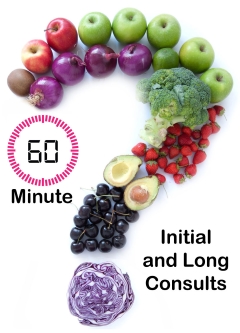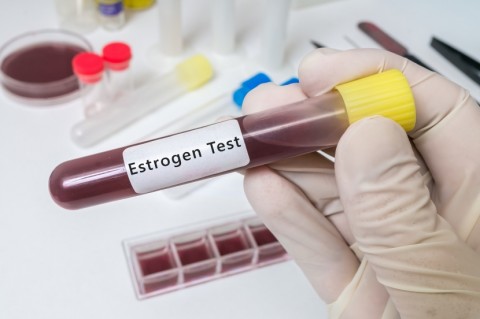DrCarney.com Blog
Is There a Blood Test for Too Much Estrogen?
"But my blood test says my estrogen level is FINE!" Imagine how many times women have told me that. Often a patient says it with palpable frustration in her voice. She's already seen her OB/GYN and been told there's no problem with her hormone levels. But since she is still experiencing symptoms like heavy monthly bleeding or disruptive night sweats, she comes to see me. When I explain that her symptoms may be due to over estrogenization, she feels exasperated — as if one of the doctors must be misleading her. And she can't figure out which one of us it is.
I understand my patient's frustration. By the time she comes to my office, a patient with heavy monthly bleeding may be anemic, which makes her feel tired. If additionally her sleep is being disrupted with night sweats, she feels beyond tired and well into exhaustion. Now it appears that she has to try to determine which doctor is telling the truth. No wonder she feels perplexed and irritated!
In all honesty I can tell her that both doctors are correct, on a certain level. One physician is looking at the level of estrogen indicated on the lab report. Since that number is within normal range, the patient has been told her estrogen level is fine. However, I'm looking at the symptoms the patient is experiencing and — recognizing what causes these symptoms — I can determine that my patient has too much estrogen at the cellular level, regardless of what the lab tests show.
The Anatomy of a Blood Test
To understand how a patient with a normal level of estrogen on a lab test can still be experiencing the effects of over estrogenization at the cellular level, we have to get a little technical about how a blood test works.
There are three reasons why a blood test may not indicate a person's estrogen exposure at the cellular level. First, estrogen can hide. It often moves through the blood encased in a protein wrapper. This wrapper prevents the estrogen from being detected by the testing reagents. Second, estrogen is lipophilic (fat-loving), so it sticks tightly to the cell membrane of the red blood cells. A laboratory does not test the red blood cells, but rather it tests the blood serum, the liquid component of blood. Therefore, the estrogen attached to the red blood cells goes undetected by the lab. Finally, the way a lab determines normal amounts of estrogen is based on data collected from a population and plotted on a bell curve. This bell curve reflects the reality of a population, not the ideal for that population. For an over estrogenized population like the United States, the typical level of estrogen is much higher than what is best. But since high levels of estrogen are the norm, a patient may quite naturally be told that her estrogen level is normal when it is actually high.
Blood Tests Versus Symptoms
Since a simple blood test done in most laboratories cannot reliably tell us if there is too much estrogen in the blood stream, practitioners must look at the symptoms to help them determine the cause of a patient's problems. Heavy, painful periods, difficult or prolonged menopause, precocious puberty in girls or delayed puberty in boys, obesity, and certain types of cancers (breast, ovarian, uterine, and prostate) are all associated with elevated levels of estrogen continually bathing the cells of the body.
After I explain to my patient how it is possible for her to have a lab report that indicates normal levels of estrogen while she has a body that is telling her differently, my patient usually begins to calm down. That's when we can get to work. I explain to her the eight ways that the typical Western diet, which is heavy in animal products and processed foods, contributes to too much estrogen. By the end of our appointment, my patient has usually committed to making some changes in her diet in order to improve her health.
Diet and Estrogen
A low-fat diet of whole plant foods is surprisingly effective in lowering the amount of estrogen reaching our cells and wreaking havoc with our bodies. "Beans, Greens, Squash, and Yams" is the meal mantra I teach my patients. If twice a day we fill our plates with foods from these four categories, and then add a lighter meal of fruits and grains once a day, our bodies will respond with surprising health and energy. I call this the Starch-Smart® System, but any whole-foods, plant-based diet devoid of oil and with limited amounts of higher-fat plant foods like nuts and seeds will produce similar results. I invite you to make the switch to eating this way and experience the healing and vitality possible when you fuel your life with plants.
Additional blogs in this series:
(1) Eating Meat Raises Estrogen at Cellular Levels
(2) Milk Makes Estrogen Levels Rise
One Hour Phone Consult with Dr. Carney

Telephone Food Coaching Sessions with Linda Carney MD
Due to demand for nutritional advice, Dr. Carney's offers Starch-Smart® System "Dietary Care Extraordinaire" Food Coaching telephone sessions. The first sessions is always one hour. Subsequent sessions can be thirty minutes or one hour:
Click Here For 60 Minute Food Coaching Session
Please Note: Food Coaching sessions are not medical appointments and are not intended to replace your own physician. No tests will be ordered and no prescriptions will be provided.
When you subscribe to the blog, we will send you an e-mail when there are new updates on the site so you wouldn't miss them.




